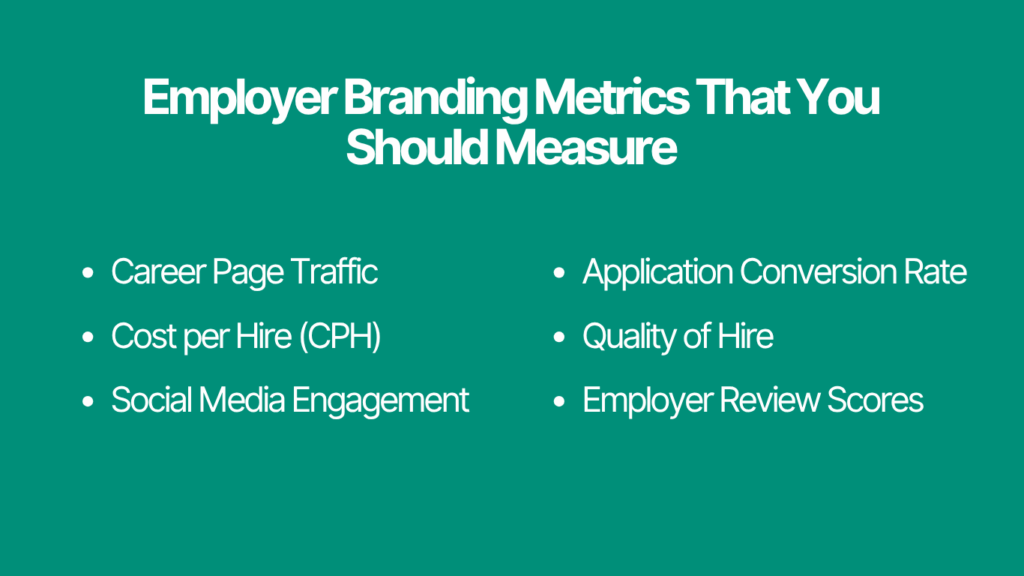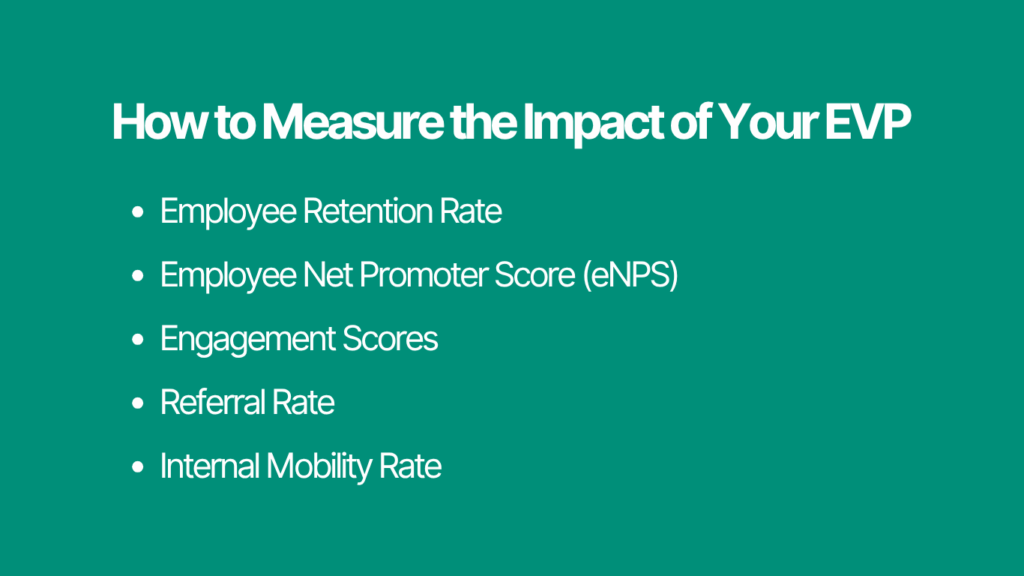Employer Branding (EB) and Employee Value Proposition (EVP) are closely related and often used together, but they serve different roles in shaping your company’s reputation.
According to LinkedIn Talent Solutions, companies with a strong EVP experience 29% higher employee engagement and significantly lower turnover.
So, it is important to understand both terms. At the simplest level, Employer Branding is how your organization is perceived from the outside, while Employee Value Proposition defines what your company offers employees on the inside.
When these two align, you attract the right candidates, build trust, and strengthen retention. But when they’re out of sync, it creates a credibility gap that harms both hiring and reputation.
In this blog, you’ll learn the key differences between Employer Branding and Employee Value Proposition and how both work together to build a strong, authentic employer brand strategy.
Let’s start with understanding employer branding.
What Is Employer Branding (EB)?
In today’s job market, candidates research companies before applying, read reviews on Glassdoor, and check how organizations treat their teams online. According to Glassdoor, 84% of job seekers say a company’s employer brand influences their decision to apply.
So, Employer Branding (EB) is how your company is perceived as a place to work, both by potential candidates and current employees. It’s the reputation you build through everything people see, hear, and experience about your organization.
A strong employer branding strategy helps your company attract and retain top talent by creating a consistent, positive image of what it’s like to work there.
A strong employer brand communicates three things clearly:

When these elements align, your company naturally attracts candidates who share your values and are more likely to stay longer. For example, a brand that promotes transparency and fairness, like WorkSure, which focuses on verified employment and trust, builds credibility that appeals to both job seekers and existing employees.
In short, employer branding defines your reputation as an employer.
What Is Employee Value Proposition (EVP)?
Employee Value Proposition (EVP) is the unique mix of benefits, rewards, and experiences your company offers to employees in exchange for their skills, time, and commitment. At its core, a strong EVP answers one simple question:
“Why should someone choose to work for your company and stay?”
Your EVP goes beyond salary or benefits. It’s the complete package, the tangible and emotional reasons employees value being part of your organization. This includes:

According to Gartner, organizations with a compelling EVP can decrease annual employee turnover by up to 70% and increase new hire commitment by nearly 30%. That’s why defining and communicating your EVP clearly is a critical part of modern HR strategy.
A well-defined EVP also strengthens your employer branding strategy. When employees feel valued and connected to the company’s mission, they become brand advocates. This organic advocacy transforms good workplaces into admired employer brands.
Employer Branding vs Employee Value Proposition: Key Differences
Although Employer Branding (EB) and Employee Value Proposition (EVP) are deeply connected, they serve distinct purposes within your talent strategy. To build an authentic and consistent employer brand, it is important to understand the key differences between these two.
Here’s a quick comparison:
| Aspect | Employer Branding (EB) | Employee Value Proposition (EVP) |
| Focus | How your company is perceived externally by candidates, clients, and the public | What your company offers internally to employees |
| Purpose | Attract and engage potential talent | Retain and motivate existing employees |
| Ownership | Usually led by HR and Marketing | Driven by HR, leadership, and internal communications |
| Output | Reputation, storytelling, and content that shape perception | Tangible and emotional benefits — pay, culture, growth, purpose |
| Measure of Success | Brand reach, application volume, sentiment | Engagement, retention, employee satisfaction |
| Relationship | Communicates the EVP to the outside world | Forms the foundation of the Employer Brand |
According to LinkedIn’s Global Talent Trends Report (2024), companies that align their EVP and Employer Brand see 2x faster hiring and 50% higher retention compared to those with disconnected messaging. These numbers highlight when your EVP and EB work together, your organization becomes more trustworthy and consistent across every touchpoint.
Authentic alignment, on the other hand, drives growth. The Universum Global Employer Branding Report (2025) found that companies with consistent EB-EVP alignment receive 60% more qualified applicants.
How to Build an Employee Value Proposition (EVP) That Strengthens Your Employer Brand
Building a strong Employee Value Proposition (EVP) is one of the most effective ways to enhance your Employer Branding strategy. A well-defined EVP builds trust, improves retention, and makes your employer brand more authentic and competitive.
Here’s how to build an employee value proposition:
- Start with employee insight
- Identify your core EVP pillars
- Translate insights into authentic messaging
- Reflect your EVP in employer branding
- Keep your EVP relevant

Here is a detailed description of each of these.
1. Start with Employee Insight
Every great EVP begins with listening. Use employee surveys, stay interviews, and feedback sessions to understand what people genuinely value. According to Gartner’s HR Insights 2024, 65% of employees leave due to a mismatch between perceived and actual workplace culture. Listening early helps close that gap before it affects engagement or reputation.
2. Identify Your Core EVP Pillars
Once you understand employee priorities, define your company’s key EVP pillars. Most organizations center around 4–5 consistent themes such as growth, impact, inclusivity, and balance.
Each pillar should reflect what employees already experience and what leadership commits to delivering. A realistic EVP builds credibility; an aspirational one without proof can harm your brand.
3. Translate Insights into Authentic Messaging
Your EVP should sound genuine and human. Replace broad claims like “We care about innovation” with proof-driven language, “we encourage curiosity — every idea gets tested, no matter where it comes from.”
This tone connects emotionally with candidates while keeping your employer branding voice credible and grounded.
4. Reflect Your EVP in Employer Branding
An EVP only becomes powerful when it’s visible and consistent. Apply it across your career site, social media, and hiring campaigns. The best brands don’t just claim values, they show them through real stories. Examples:
- LinkedIn: “Transformation through opportunity.”
- HubSpot: “Work and life should fit together.”
- WorkSure: “Transparency and trust through verified employment.”
Each brand takes internal truths and expresses them externally, strengthening authenticity and attracting aligned talent.
5. Keep Your EVP Alive and Relevant
An EVP must evolve with your people and the world around them. Revisit it yearly to align with changing expectations, hybrid work models, and emerging cultural shifts. The Universum Global Employer Branding Survey (2025) found that companies that regularly refresh their EVP report 27% higher employee satisfaction and stronger retention.
Measuring Success: EB & EVP Metrics to Track
Defining your Employer Branding (EB) and Employee Value Proposition (EVP) is only half the work — the real impact shows in how people respond to them. Measuring success helps you understand what’s working, what’s not, and where your message needs refinement.
1. Employer Branding Metrics That You Should Measure
Your employer brand metrics should measure how effectively you attract and engage the right talent. Key indicators include:
- Career Page Traffic: Tracks how many people explore your job or culture pages. A steady increase suggests your messaging resonates.
- Application Conversion Rate: Measures how many visitors actually apply after visiting a job page. It is an indicator of how compelling your brand story is.
- Cost per Hire (CPH): Strong brands lower recruitment costs by up to 43%, according to LinkedIn Talent Solutions.
- Quality of Hire: Monitors how well new hires perform or stay, showing if you’re attracting the right talent, not just more applicants.
- Social Media Engagement: Likes, shares, and comments on posts that feature employee stories reflect authentic interest in your culture.
- Employer Review Scores: Ratings on platforms like Glassdoor show how employees perceive the brand internally.

2. How to Measure the Impact of Your EVP
Unlike employer branding, EVP metrics focus on the internal experience, how employees feel about your promises, culture, and growth opportunities. Meaningful KPIs include:
- Employee Retention Rate: If your EVP is strong, people stay longer. High voluntary turnover signals a misalignment between message and reality.
- Employee Net Promoter Score (eNPS): Measures how likely employees are to recommend your organization as a workplace.
- Engagement Scores: Regular surveys can track motivation, belonging, and satisfaction — key indicators of EVP health.
- Referral Rate: When employees refer others, it’s proof that your EVP delivers what it promises.
- Internal Mobility Rate: A growing rate of internal transfers or promotions indicates that employees see room for development and trust your system.

According to Gartner’s 2024 HR Benchmark Report, companies that actively track and adjust their EVP see 50% higher engagement and 28% lower turnover than those that don’t.
3. Combining EB and EVP Data for a Complete Picture
The real insight comes from connecting external brand perception with internal sentiment. When candidates and employees tell the same story, your brand is authentic. You can create a simple Employer Brand Health Dashboard that merges:
- External metrics (reach, applications, reviews)
- Internal metrics (engagement, retention, eNPS)
This unified view helps you identify patterns. For example:
- If your brand campaigns are driving traffic but retention is low, your EVP may need adjustment.
- If engagement is high but hiring remains slow, your employer brand message might not be reaching the right audience.
When EVP and EB data align, your employer brand becomes measurable, manageable, and meaningful.
Conclusion: Turning Alignment Into Authentic Employer Value
In the end, Employer Branding (EB) and Employee Value Proposition (EVP) are connected forces that shape how people experience your company. EVP defines the truth of your workplace; EB ensures that truth is seen, heard, and trusted.
When those two align, the impact goes far beyond recruitment. You build a reputation rooted in integrity, where candidates see consistency between what’s promised and what employees actually live. That’s what creates belonging, advocacy, and long-term loyalty.
For organizations focused on sustainable growth, like WorkSure, alignment between EVP and EB is a trust strategy. It’s what helps you attract talent who share your values and stay because those values hold true.
Frequently Asked Questions (FAQs)
1. What is the difference between EB and EVP?
Employer Branding (EB) is how your company is perceived as a place to work — it shapes external reputation. Employee Value Proposition (EVP) defines what employees actually receive in return for their work, the culture, purpose, and benefits they experience.
2. What does EVP stand for?
EVP stands for Employee Value Proposition. It represents the unique set of offerings, rewards, and experiences a company provides to attract, motivate, and retain employees.
3. What do you mean by EVP in HR?
In HR, Employee Value Proposition refers to the total value an employee gains from being part of the organization, including pay, growth, culture, purpose, and recognition.
It’s the foundation for recruitment, engagement, and retention strategies, guiding how you communicate your company’s identity as an employer.
4. What is Apple’s EVP?
Apple’s Employee Value Proposition centers around innovation, inclusion, and impact. It promises employees the opportunity to “make a difference through technology” while working in a culture that values creativity, collaboration, and continuous learning. Apple’s EVP supports its employer brand — “Join us. Be you.” — by combining purpose with personal growth.





